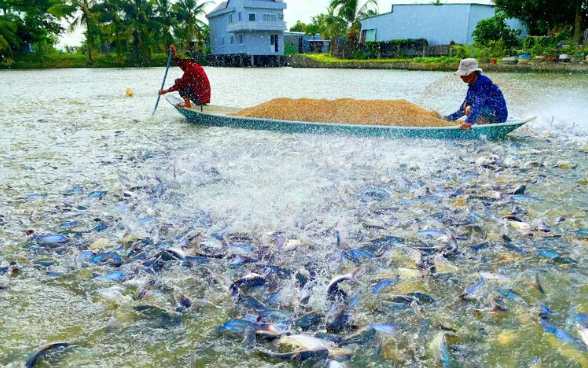(seafood.vasep.com.vn) As climate change continues to intensify, Vietnam’s aquaculture industry is facing unprecedented challenges. Among the most affected is the Mekong Delta, where rising temperatures, saline intrusion, and lower water levels are disrupting the delicate ecological balance. In response, many farmers and enterprises are adopting climate-resilient pangasius farming models—marking a promising and sustainable direction for the industry.

Pangasius, a signature product of the Mekong Delta, has long been one of Vietnam’s key seafood exports. But environmental changes are threatening the very conditions that make pangasius farming viable. Climate experts warn that the Mekong Delta is highly vulnerable to the impacts of global warming. Salinity intrusion, irregular water levels, and fluctuating temperatures are making it increasingly difficult to maintain suitable water quality for aquaculture.
To adapt, many fish farmers are turning to high-tech farming solutions. These include lined pond systems, water recirculation technologies, and oxygen monitoring sensors. Such innovations have helped mitigate the effects of salinity and unstable water sources, ensuring export-standard product quality. In fact, farmers using these technologies have reported a 15% increase in selling prices.
At the same time, the industry is investing in disease-resistant pangasius breeds—particularly those that can tolerate brackish water. These new strains are helping reduce dependence on antibiotics, which benefits both the environment and public health.
Sustainability standards like ASC (Aquaculture Stewardship Council) and GlobalG.A.P are also gaining traction across the sector. These certifications not only enhance the export value of Vietnamese pangasius but also promote responsible farming practices and natural resource conservation.
One notable initiative launched in 2024 is the "river-in-pond" pangasius farming model in Chau Phu District, An Giang Province. This system uses concrete-bottomed ponds equipped with wave makers, aerators, paddle wheels, and waste suction devices to create a controlled water flow. The result: a consistently clean aquatic environment, reduced pollution, and lower disease risk. According to local authorities, farmers who implemented this model saw production increase by 20–30% compared to traditional methods, while also saving on environmental treatment and antibiotic costs. Reusing water has significantly reduced pollution levels.
In Cao Lanh District of Dong Thap Province, many pangasius farms are adopting ASC-certified practices to meet international market demands. These farms emphasize environmental management, traceable feed, and minimal antibiotic use. The shift has brought measurable results—production costs have dropped by 10–15%, while product prices have risen by 5–10%.
Trần Văn Hải, a farmer in Bình Thạnh Commune, shared: “Since switching to ASC-certified farming, I’ve seen clear improvements. The fish are healthier, there’s less disease, and prices are better than before.”
The adoption of advanced models like "river-in-pond" systems and ASC certification not only boosts economic performance but also contributes to environmental protection and the long-term sustainability of Vietnam’s pangasius industry. These models show that climate-resilient pangasius farming is not only a sustainable solution but also a key to food security and international competitiveness.
In the first four months of 2025, Vietnam’s cumulative pangasius harvest was estimated at 531,300 tons—up 4.8% year-on-year. Raw pangasius prices remained stable and even showed an upward trend from late 2024 through early March 2025, providing farmers with renewed motivation to maintain and expand production.